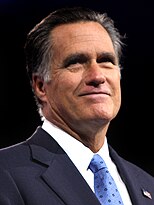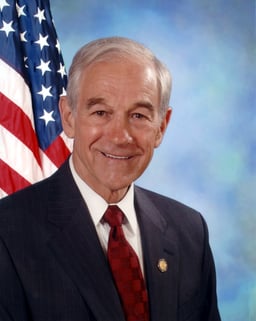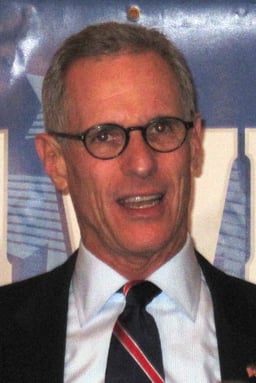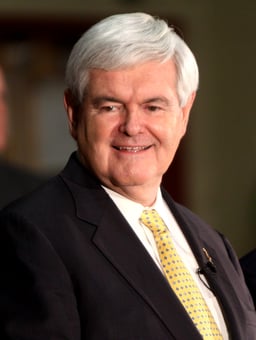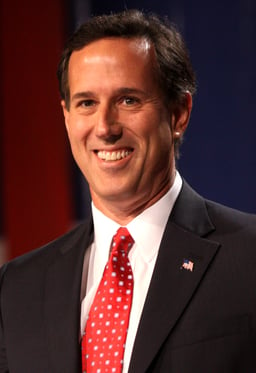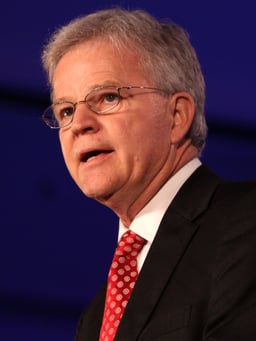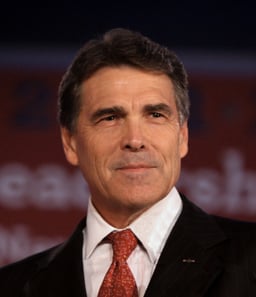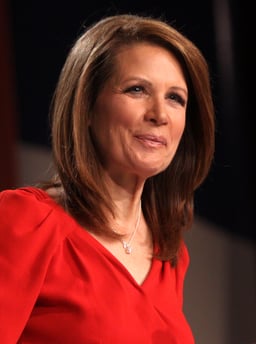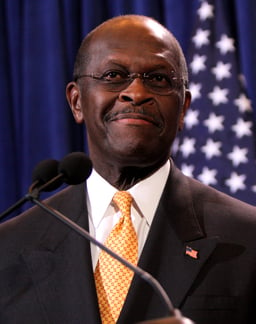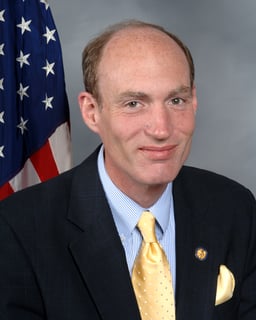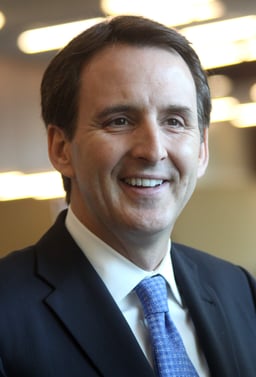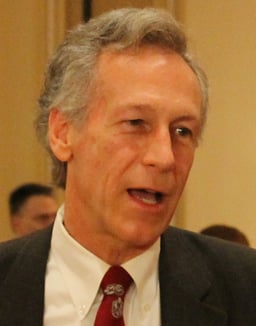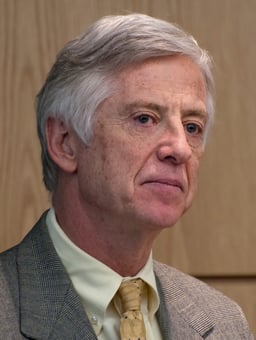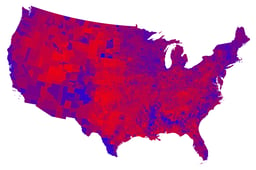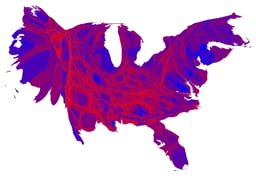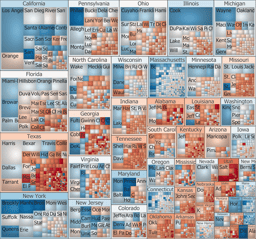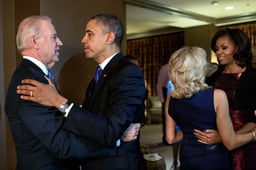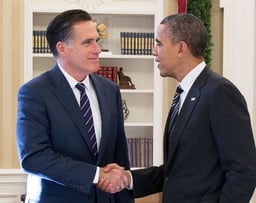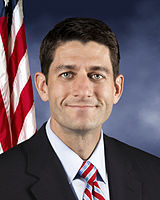United States presidential election, 2012

United States presidential election, 2012

| |||||||||||||||||||||||||||||
All 538 electoral votes of the Electoral College 270 electoral votes needed to win | |||||||||||||||||||||||||||||
|---|---|---|---|---|---|---|---|---|---|---|---|---|---|---|---|---|---|---|---|---|---|---|---|---|---|---|---|---|---|
| Opinion polls | |||||||||||||||||||||||||||||
| Turnout | 54.9%[1] | ||||||||||||||||||||||||||||
| |||||||||||||||||||||||||||||
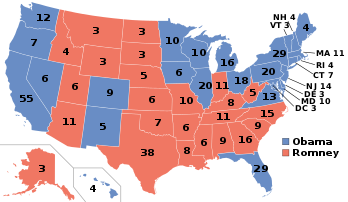 Presidential election results map.Bluedenotes those won by Obama/Biden,reddenotes states won by Romney/Ryan. Numbers indicate electoral votes allotted to the winner of each state. | |||||||||||||||||||||||||||||
| |||||||||||||||||||||||||||||
The 2012 United States presidential election was the 57th quadrennial American presidential election, held on Tuesday, November 6, 2012. The Democratic nominee, President Barack Obama, and his running mate, Vice President Joe Biden, were elected to a second term. They defeated the Republican ticket of businessman and former Governor Mitt Romney of Massachusetts and Representative Paul Ryan of Wisconsin.
As the incumbent president, Obama secured the Democratic nomination with no serious opposition. The Republicans experienced a competitive primary. Romney was consistently competitive in the polls and won the support of many party leaders, but he faced challenges from a number of more conservative contenders. Romney clinched his party's nomination in May, defeating Rick Santorum, Newt Gingrich, and several other candidates.
The campaigns focused heavily on domestic issues, and debate centered largely around sound responses to the Great Recession. Other issues included long-term federal budget issues, the future of social insurance programs, and the Affordable Care Act, Obama's marquee legislative program. Foreign policy was also discussed, including the phase-out of the Iraq War, military spending, the Iranian nuclear program, and appropriate counteractions to terrorism. The campaign was marked by a sharp rise in fundraising, including from nominally independent Super PACs.
Obama defeated Romney, winning a majority of both the popular vote and the Electoral College. Obama won 51.1% of the popular vote compared to Romney's 47.2%. Obama was the first incumbent since Franklin D. Roosevelt in 1944 to win reelection with fewer electoral votes and a lower popular vote percentage than had been won in the previous election, and was also the first two-term president since Ronald Reagan to win both his presidential bids with a majority of the nationwide popular vote. This was also the first presidential election since 1944 in which neither candidate had military experience. Obama did not hold onto Indiana and North Carolina, but crucially won the entire blue wall and defeated Romney in other swing states the Republicans had held in 2000 and 2004, the largest of which being Florida and Ohio, giving Obama a clear path to victory.
| |||||||||||||||||||||||||||||
All 538 electoral votes of the Electoral College 270 electoral votes needed to win | |||||||||||||||||||||||||||||
|---|---|---|---|---|---|---|---|---|---|---|---|---|---|---|---|---|---|---|---|---|---|---|---|---|---|---|---|---|---|
| Opinion polls | |||||||||||||||||||||||||||||
| Turnout | 54.9%[1] | ||||||||||||||||||||||||||||
| |||||||||||||||||||||||||||||
 Presidential election results map.Bluedenotes those won by Obama/Biden,reddenotes states won by Romney/Ryan. Numbers indicate electoral votes allotted to the winner of each state. | |||||||||||||||||||||||||||||
| |||||||||||||||||||||||||||||
State changes to voter registration and electoral rules
In 2011, several state legislatures passed new voting laws, especially pertaining to voter identification, with the stated purpose of combating voter fraud; the laws were attacked, however, by the Democratic Party as attempts to suppress voting among its supporters and to improve the Republican Party's presidential prospects. Florida, Georgia, Ohio,[2] Tennessee, and West Virginia's state legislatures approved measures to shorten early voting periods. Florida and Iowa barred all felons from voting. Kansas, South Carolina,[3] Tennessee, Texas[4] and Wisconsin[5] state legislatures passed laws requiring voters to have government-issued IDs before they could cast their ballots. This meant, typically, that people without driver's licenses or passports had to gain new forms of ID. Obama, the NAACP, and the Democratic Party fought against many of the new state laws.[6] Former President Bill Clinton denounced them, saying, "There has never been in my lifetime, since we got rid of the poll tax and all the Jim Crow burdens on voting, the determined effort to limit the franchise that we see today".[7] He was referring to Jim Crow laws passed in southern states near the turn of the twentieth century that disenfranchised most blacks from voting and excluded them from the political process for more than six decades. Clinton said the moves would effectively disenfranchise core voter blocs that trend liberal, including college students, Blacks, and Latinos.[8][9] Rolling Stone magazine criticized the American Legislative Exchange Council (ALEC) for lobbying in states to bring about these laws, to "solve" a problem that does not exist.[6] The Obama campaign fought against the Ohio law, pushing for a petition and statewide referendum to repeal it in time for the 2012 election.[10]
In addition, the Pennsylvania legislature proposed a plan to change its representation in the electoral college from the traditional winner-take-all model to a district-by-district model.[11] As the governorship and both houses of its legislature were Republican-controlled, the move was viewed by some as an attempt to reduce Democratic chances.[12][13][14]
Nominations
Democratic Party
Primaries
With an incumbent president running for re-election against token opposition, the race for the Democratic nomination was largely uneventful. The nomination process consisted of primaries and caucuses, held by the 50 states, as well as Guam, Puerto Rico, Washington, D.C., U.S. Virgin Islands, American Samoa, and Democrats Abroad. Additionally, high-ranking party members known as superdelegates each received one vote in the convention. A few of the primary challengers surpassed the president's vote total in individual counties in several of the seven contested primaries, though none made a significant impact in the delegate count. Running unopposed everywhere else, President Obama cemented his status as the Democratic presumptive nominee on April 3, 2012, by securing the minimum number of pledged delegates needed to obtain the nomination.[15][16]
Candidate
Democratic Party ticket, 2012 | |||||||||||||||||||||||||||||
| Barack Obama | Joe Biden | ||||||||||||||||||||||||||||
|---|---|---|---|---|---|---|---|---|---|---|---|---|---|---|---|---|---|---|---|---|---|---|---|---|---|---|---|---|---|
| for President | for Vice President | ||||||||||||||||||||||||||||
| 44th President of the United States (2009–2017) | 47th Vice President of the United States (2009–2017) | ||||||||||||||||||||||||||||
| Campaign | |||||||||||||||||||||||||||||
Republican Party
Primaries
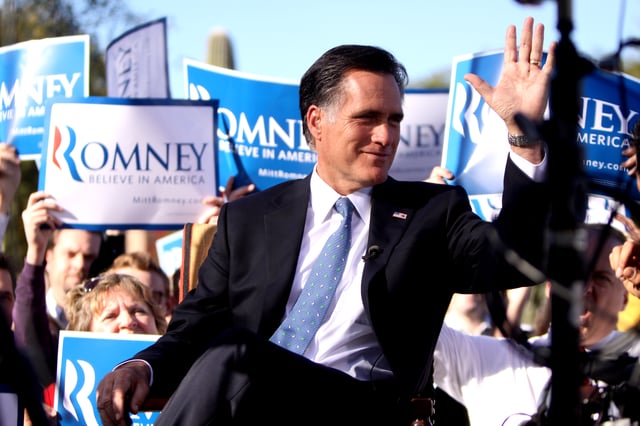
Mitt Romney on the campaign trail
Candidates with considerable name recognition who entered the race for the Republican presidential nomination in the early stages of the primary campaign included U.S. Representative and former Libertarian nominee Ron Paul, former Minnesota Governor Tim Pawlenty, who co-chaired John McCain's campaign in 2008, former Massachusetts Governor Mitt Romney, the runner-up for the nomination in the 2008 cycle, and former Speaker of the House Newt Gingrich.
The first debate took place on May 5, 2011, in Greenville, South Carolina, with businessman Herman Cain, former New Mexico Governor Gary Johnson, Ron Paul, Tim Pawlenty, and former Pennsylvania Senator Rick Santorum participating. Another debate took place a month later, with Newt Gingrich, Mitt Romney, former Utah Governor Jon Huntsman, and Minnesota Congresswoman Michele Bachmann participating, and Gary Johnson excluded. A total of thirteen debates were held before the Iowa caucuses.
The first major event of the campaign was the Ames Straw Poll, which took place in Iowa on August 13, 2011. Michele Bachmann won the straw poll (this ultimately proved to be the acme of her campaign).[17] Pawlenty withdrew from the race after a poor showing in the straw poll, as did Thaddeus McCotter, the only candidate among those who qualified for the ballot who was refused entrance into the debate.[18]
It became clear at around this point in the nomination process that while Romney was considered to be the likely nominee by the Republican establishment, a large segment of the conservative primary electorate found him to be too moderate for their political views. As a result, a number of potential "anti-Romney" candidates were put forward,[19][20] including future President Donald Trump,[21] former Alaska Governor and 2008 vice-presidential nominee Sarah Palin,[22] New Jersey Governor Chris Christie,[23] and Texas Governor Rick Perry,[24] the last of whom decided to run in August 2011. Perry did poorly in the debates, however, and Herman Cain and then Newt Gingrich came into the fore in October and November.
For the first time in modern Republican Party history, three different candidates won the first three state contests in January (the Iowa caucuses, the New Hampshire primary, and the South Carolina primary).[27] Although Romney had been expected to win in at least Iowa and New Hampshire, Rick Santorum won the non-binding poll at caucus sites in Iowa by 34 votes, as near as can be determined from the incomplete tally, earning him a declaration as winner by state party leaders, although vote totals were missing from eight precincts.[28][29] The election of county delegates at the caucuses would eventually lead to Ron Paul earning 22 of the 28 Iowa delegates to the Republican National Convention.[30] Newt Gingrich won South Carolina by a surprisingly large margin,[31] and Romney won only in New Hampshire.
Santorum, who had previously run an essentially one-state campaign in Iowa, was able to organize a national campaign after his surprising victory there. He unexpectedly carried three states in a row on February 7 and overtook Romney in nationwide opinion polls, becoming the only candidate in the race to effectively challenge the notion that Romney was the inevitable nominee.[34] However, Romney won all of the other contests between South Carolina and the Super Tuesday primaries, and regained his first-place status in nationwide opinion polls by the end of February.
The Super Tuesday primaries took place on March 6. Romney carried six states, Santorum carried three, and Gingrich won only in his home state of Georgia.[35] Throughout the rest of March, 266 delegates were allocated in 12 events, including the territorial contests and the first local conventions that allocated delegates (Wyoming's county conventions). Santorum won Kansas and three Southern primaries, but he was unable to make any substantial gain on Romney, who became a formidable frontrunner after securing more than half of the delegates allocated in March.
On April 10, Santorum suspended his campaign due to a variety of reasons, such as a low delegate count, unfavorable polls in his home state of Pennsylvania, and his daughter's health, leaving Mitt Romney as the undisputed front-runner for the presidential nomination and allowing Gingrich to claim that he was "the last conservative standing" in the campaign for the nomination.[36] After disappointing results in the April 24 primaries (finishing second in one state, third in three, and fourth in one), Gingrich dropped out on May 2 in a move that was seen as an effective end to the nomination contest.[37] After Gingrich's spokesman announced his upcoming withdrawal, the Republican National Committee declared Romney the party's presumptive nominee.[38] Ron Paul officially remained in the race, but he stopped campaigning on May 14 to focus on state conventions.
On May 29, after winning the Texas primary, Romney had received a sufficient number of delegates to clinch the party's nomination with the inclusion of unpledged delegates. After winning the June 5 primaries in California and several other states, Romney had received more than enough pledged delegates to clinch the nomination without counting unpledged delegates, making the June 26 Utah Primary, the last contest of the cycle, purely symbolic. CNN's final delegate estimate, released on July 27, 2012, put Romney at 1,462 pledged delegates and 62 unpledged delegates, for a total estimate of 1,524 delegates. No other candidate had unpledged delegates. The delegate estimates for the other candidates were Santorum at 261 delegates, Paul at 154, Gingrich at 142, Bachmann at 1, Huntsman at 1, and all others at 0.[39]
On August 28, 2012, delegates at the Republican National Convention officially named Romney the party's presidential nominee.[40] Romney formally accepted the delegates' nomination on August 30, 2012.[41]
Candidate
Republican Party ticket, 2012 | |||||||||||||||||||||||||||||
| Mitt Romney | Paul Ryan | ||||||||||||||||||||||||||||
|---|---|---|---|---|---|---|---|---|---|---|---|---|---|---|---|---|---|---|---|---|---|---|---|---|---|---|---|---|---|
| for President | for Vice President | ||||||||||||||||||||||||||||
| 70th Governor of Massachusetts (2003–2007) | U.S. Representative from Wisconsin (1999–2019) | ||||||||||||||||||||||||||||
| Campaign | |||||||||||||||||||||||||||||
| [42][43] | |||||||||||||||||||||||||||||
Withdrawn candidates
Ron Paul, U.S. Representative from Texas (ended active campaigning on May 14, 2012; endorsed Gary Johnson continued to seek delegates from earlier primaries).[44]
Fred Karger, Political consultant and gay rights activist from California (withdrew June 29, 2012).[45]
Newt Gingrich, former U.S. Speaker of the House of Representatives, from Georgia[46][47] (withdrew on May 2, 2012, and endorsed Mitt Romney)[48]
Rick Santorum, former senator from Pennsylvania (withdrew on April 10, 2012, and endorsed Mitt Romney)[49][50][51]
Buddy Roemer, former governor of Louisiana[52][53] (withdrew on February 22, 2012, to run for the nominations of Americans Elect and the Reform Party, then endorsed Gary Johnson)
Rick Perry, Governor of Texas (withdrew on January 19, 2012, and endorsed Newt Gingrich, then Mitt Romney after Gingrich withdrew)[54][55][56]
Jon Huntsman, Jr., former U.S. ambassador to China and former governor of Utah (withdrew on January 16, 2012, and endorsed Mitt Romney)[57][58]
Michele Bachmann, U.S. Representative from Minnesota (withdrew on January 4, 2012, and endorsed Mitt Romney)[59][60][61]
Gary Johnson, former governor of New Mexico (withdrew on December 28, 2011, to run for the nomination of the Libertarian Party, endorsed Ron Paul)[62][63]
Herman Cain, businessman from Georgia (withdrew on December 3, 2011, and endorsed Newt Gingrich, then Mitt Romney after Gingrich withdrew)[64][65]
Thaddeus McCotter, U.S. Representative from Michigan (withdrew on September 22, 2011, and endorsed Mitt Romney)[66][67]
Tim Pawlenty, former governor of Minnesota (withdrew on August 14, 2011, and endorsed Mitt Romney)[68][69]
Third party and other nominations
Four other parties nominated candidates that had ballot access or write-in access to at least 270 electoral votes, the minimum number of votes needed in the 2012 election to win the presidency through a majority of the electoral college.
Libertarian Party
Green Party
Jill Stein, medical doctor from Massachusetts.[72][73] Vice-presidential nominee: Cheri Honkala, social organizer, from Pennsylvania.[74]
Constitution Party
Justice Party
Candidates gallery
Campaigns
Ballot access
| Presidential ticket | Party | Ballot access[79] | Votes | Percentage | ||
|---|---|---|---|---|---|---|
| States | Electors | % of voters | ||||
| Obama / Biden | Democratic | 50 + DC | 538 | 100% | 65,915,795 | 51.19% |
| Romney / Ryan | Republican | 50 + DC | 538 | 100% | 60,933,504 | 47.32% |
| Johnson / Gray | Libertarian | 48 + DC | 515 | 95.1% | 1,275,971 | 0.99% |
| Stein / Honkala | Green | 36 + DC | 436 | 83.1% | 469,627 | 0.36% |
| Goode / Clymer | Constitution | 26 | 257 | 49.9% | 122,388 | 0.09% |
| Anderson / Rodriguez | Justice | 15 | 145 | 28.1% | 43,018 | 0.03% |
| Lindsay / Osorio | Socialism & Liberation | 13 | 115 | 28.6% | 7,791 | 0.006% |
Candidates in bold were on ballots representing 270 electoral votes.
All other candidates were on the ballots of fewer than 10 states, 100 electors, and less than 20% of voters nationwide.
Financing and advertising
The United States presidential election of 2012 broke new records in financing, fundraising, and negative campaigning. Through grassroots campaign contributions, online donations, and Super PACs, Obama and Romney raised a combined total of more than $2 billion.[80] Super PACs constituted nearly one-fourth of the total financing, with most coming from pro-Romney PACs.[81] Obama raised $690 million through online channels, beating his record of $500 million in 2008.[82] Most of the advertising in the 2012 presidential campaign was decidedly negative—80% of Obama's ads and 84% of Romney's ads were negative.[83] The tax-exempt non-profit Americans for Prosperity, a so-called "outside group", that is, a political advocacy group that is not a political action committee or super-PAC, ran a television advertising campaign opposing Obama described by The Washington Post as "early and relentless".[84][85] Americans for Prosperity spent $8.4 million in swing states on television advertisements denouncing the American Recovery and Reinvestment Act of 2009 loan guarantee to Solyndra, a manufacturer of solar panels that went bankrupt,[86] an advertising campaign described by The Wall Street Journal in November 2011 as "perhaps the biggest attack on Mr. Obama so far".[87][88]
Party conventions

Sites of the 2012 national party conventions.
April 18–21, 2012: 2012 Constitution Party National Convention held in Nashville, Tennessee;[89] Virgil Goode won the nomination.
May 3–6, 2012: 2012 Libertarian National Convention held in Las Vegas, Nevada;[90] Gary Johnson won the nomination.[91]
July 13–15, 2012: 2012 Green National Convention held in Baltimore, Maryland;[92] Jill Stein won the nomination.[72]
August 27–30, 2012: 2012 Republican National Convention held in Tampa, Florida;[93] Mitt Romney won the nomination.
September 3–6, 2012: 2012 Democratic National Convention held in Charlotte, North Carolina;[94] Barack Obama won the nomination.
Debates
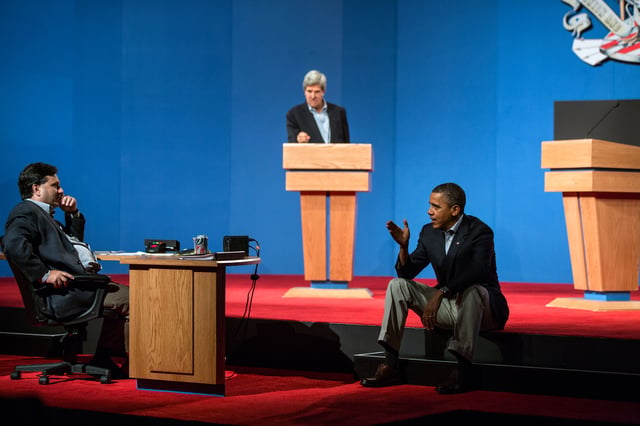
President Obama talks with Ron Klain during presidential debate preparations. Senator John Kerry, at podium, played the role of Mitt Romney during the preparatory sessions.
The Commission on Presidential Debates held four debates during the last weeks of the campaign: three presidential and one vice-presidential. The major issues debated were the economy and jobs, the federal budget deficit, taxation and spending, the future of Social Security, Medicare, and Medicaid, healthcare reform, education, social issues, immigration, and foreign policy.
Debate schedule:
| No. | Date | Host | City | Moderator | Participants | Viewership (Million) |
|---|---|---|---|---|---|---|
| P1 | Wednesday, October 3, 2012 | University of Denver | Denver, Colorado | Jim Lehrer | President Barack ObamaGovernor Mitt Romney | 67.2[95] |
| VP | Thursday, October 11, 2012 | Centre College | Danville, Kentucky | Martha Raddatz | Vice President Joe BidenCongressman Paul Ryan | 51.4[95] |
| P2 | Tuesday, October 16, 2012 | Hofstra University | Hempstead, New York | Candy Crowley | President Barack ObamaGovernor Mitt Romney | 65.6[95] |
| P3 | Monday, October 22, 2012 | Lynn University | Boca Raton, Florida | Bob Schieffer | President Barack ObamaGovernor Mitt Romney | 59.2[95] |
An independent presidential debate featuring minor party candidates took place on Tuesday, October 23 at the Hilton Hotel in Chicago, Illinois.[98][99] The debate was moderated by Larry King[100] and organized by the Free & Equal Elections Foundation.[99] The participants were Gary Johnson (Libertarian), Jill Stein (Green), Virgil Goode (Constitution), and Rocky Anderson (Justice).[99][100] A second debate between Stein and Johnson took place on Monday, November 5 in Washington, D.C.[101][102] It was hosted by RT and moderated by Thom Hartmann and Christina Tobin.[103]
Notable expressions, phrases, and statements
Severely conservative – In a speech he made at the Conservative Political Action Conference in February 2012, Romney claimed that he had been a "severely conservative Republican governor". Romney's description of his record as "severely conservative" was widely criticized by political commentators as both rhetorically clumsy and factually inaccurate.[104][105][106] Later, the phrase "severely conservative" was frequently brought up by Democrats to make fun of Romney's willingness to associate himself with the far-right of the Republican Party as well as his apparent lack of sincerity while doing so.[107] Conservative radio host Rush Limbaugh, who played the clip on his radio show, said: "I have never heard anybody say, 'I'm severely conservative.' "[108]
You didn't build that – A portion of a statement that Obama made in a July 2012 campaign speech in Roanoke, Virginia. Obama said that businesses depend on government-provided infrastructure to succeed, but critics of his remarks argued that he was underplaying the work of entrepreneurs and giving the government credit for individuals' success. The Romney campaign immediately jumped on the statement in an effort to drive a wedge between Obama and small business owners/employees. A major theme of the 2012 Republican National Convention was "We Built It".
47 percent – An expression Romney used at a private campaign fundraising event, which was secretly recorded and publicly released. At the private event, Romney said that 47 percent of the people would vote for Barack Obama no matter what Romney said or did because those people "...are dependent upon government... I'll never convince them they should take personal responsibility and care for their lives".
Binders full of women – A phrase that Romney used in the second presidential debate to refer to the long list of female candidates that he considered when choosing his cabinet members as Governor of Massachusetts.
Horses and bayonets - After Romney said in the third presidential debate that the U.S. Navy was smaller than at any time since 1917, Obama replied, "We have fewer ships than we did in 1916. Well, governor, we also have fewer horses and bayonets, because the nature of our military's changed."[109]
Shovel-ready jobs – a phrase used to describe some stimulus projects promoted by the administration. During the debate on September 23, 2011, Gary Johnson quipped, "My next-door neighbor's two dogs have created more shovel-ready jobs than this president."[110]
Romnesia – A term coined by a blogger in April 2011 and used by Obama late in the campaign to describe Romney's alleged inability to take responsibility for his past statements.[111][112]
$10,000 bet – During a Republican debate, Romney facetiously bet Texas governor Rick Perry $10,000 that he (Perry) was wrong about Romney's position on the individual mandate under the Affordable Healthcare Act. The statement was vilified by Democrats as exemplary of Romney being out of touch with the average American.
Romneyshambles – a phrase used by the British press after Romney criticized British preparations for the 2012 Summer Olympics, which was a play on omnishambles. The phrase became a popular hashtag on Twitter and was later chosen as one of Collins English Dictionary's words of the year.[113][114]
Results
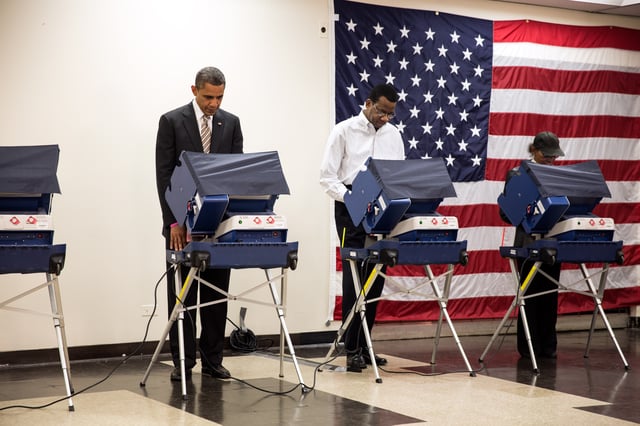
President Obama casts his ballot at the Martin Luther King Jr. Community Center in Chicago.
| Presidential candidate | Party | Home state | Popular vote | Electoral vote | Running mate | |||
|---|---|---|---|---|---|---|---|---|
| Count | Percentage | Vice-presidential candidate | Home state | Electoral vote | ||||
| Barack Hussein Obama II | Democratic | Illinois | 65,915,795 | 51.06% | 332 | Joseph Robinette Biden Jr. | Delaware | 332 |
| Willard Mitt Romney | Republican | Massachusetts | 60,933,504 | 47.20% | 206 | Paul Davis Ryan Jr. | Wisconsin | 206 |
| Gary Johnson | Libertarian | New Mexico | 1,275,971 | 0.99% | 0 | James P. Gray | California | 0 |
| Jill Stein | Green | Massachusetts | 469,627 | 0.36% | 0 | Cheri Honkala | Pennsylvania | 0 |
| Virgil Goode | Constitution | Virginia | 122,389 | 0.09% | 0 | Jim Clymer | Pennsylvania | 0 |
| Roseanne Barr | Peace and Freedom | Hawaii | 67,326 | 0.05% | 0 | Cindy Sheehan | California | 0 |
| Rocky Anderson | Justice | Utah | 43,018 | 0.03% | 0 | Luis J. Rodriguez | California | 0 |
| Tom Hoefling | America's | Iowa | 40,628 | 0.03% | 0 | J.D. Ellis | Tennessee | 0 |
| Andre Barnett | Reform | New York | 956 | <0.01% | 0 | Ken Cross | Arkansas | 0 |
| Other | 216,196 | 0.19% | — | Other | — | |||
| Total | 129,085,410 | 100% | 538 | 538 | ||||
| Needed to win | 270 | 270 | ||||||
| |||||||||||||||||||||||||||||||||||
| ||||||||||||||||||||
Results by state
The table below displays the official vote tallies by each state's Electoral College voting method. The source for the results of all states, except those that amended their official results, is the official Federal Election Commission report [171] . The column labeled "Margin" shows Obama's margin of victory over Romney (the margin is negative for every state that Romney won).
| Barack Obama Democratic | Mitt Romney Republican | Gary Johnson Libertarian | Jill Stein Green | Others | Margin | Total | ||||||||||||||
|---|---|---|---|---|---|---|---|---|---|---|---|---|---|---|---|---|---|---|---|---|
| State or district | Electoral method | % | Electoral votes | % | Electoral votes | % | Electoral votes | % | Electoral votes | % | Electoral votes | % | ||||||||
| WTA | 795,696 | 38.36% | – | 1,255,925 | 60.55% | 9 | 12,328 | 0.59% | – | 3,397 | 0.16% | – | 6,992 | 0.34% | – | −460,229 | −22.19% | 2,074,338 | AL | |
| WTA | 122,640 | 40.81% | – | 164,676 | 54.80% | 3 | 7,392 | 2.46% | – | 2,917 | 0.97% | – | 2,870 | 0.96% | – | −42,036 | −13.99% | 300,495 | AK | |
| WTA | 1,025,232 | 44.59% | – | 1,233,654 | 53.65% | 11 | 32,100 | 1.40% | – | 7,816 | 0.34% | – | 452 | 0.02% | – | −208,422 | −9.06% | 2,299,254 | AZ | |
| WTA | 394,409 | 36.88% | – | 647,744 | 60.57% | 6 | 16,276 | 1.52% | – | 9,305 | 0.87% | – | 1,734 | 0.16% | – | −253,335 | −23.69% | 1,069,468 | AR | |
| WTA | 7,854,285 | 60.24% | 55 | 4,839,958 | 37.12% | – | 143,221 | 1.10% | – | 85,638 | 0.66% | – | 115,445 | 0.89% | – | 3,014,327 | 23.12% | 13,038,547 | CA | |
| WTA | 1,323,101 | 51.49% | 9 | 1,185,243 | 46.13% | – | 35,545 | 1.38% | – | 7,508 | 0.29% | – | 18,121 | 0.71% | – | 137,858 | 5.37% | 2,569,518 | CO | |
| WTA | 905,083 | 58.06% | 7 | 634,892 | 40.73% | – | 12,580 | 0.81% | – | 863 | 0.06% | – | 5,542 | 0.36% | – | 270,191 | 17.33% | 1,558,960 | CT | |
| WTA | 242,584 | 58.61% | 3 | 165,484 | 39.98% | – | 3,882 | 0.94% | – | 1,940 | 0.47% | – | 31 | 0.01% | – | 77,100 | 18.63% | 413,921 | DE | |
| WTA | 267,070 | 90.91% | 3 | 21,381 | 7.28% | – | 2,083 | 0.71% | – | 2,458 | 0.84% | – | 772 | 0.26% | – | 245,689 | 83.63% | 293,764 | DC | |
| WTA | 4,237,756 | 50.01% | 29 | 4,163,447 | 49.13% | – | 44,726 | 0.53% | – | 8,947 | 0.11% | – | 19,303 | 0.23% | – | 74,309 | 0.88% | 8,474,179 | FL | |
| WTA | 1,773,827 | 45.48% | – | 2,078,688 | 53.30% | 16 | 45,324 | 1.16% | – | 1,516 | 0.04% | – | 695 | 0.02% | – | −304,861 | −7.82% | 3,900,050 | GA | |
| WTA | 306,658 | 70.55% | 4 | 121,015 | 27.84% | – | 3,840 | 0.88% | – | 3,184 | 0.73% | – | – | – | – | 185,643 | 42.71% | 434,697 | HI | |
| WTA | 212,787 | 32.62% | – | 420,911 | 64.53% | 4 | 9,453 | 1.45% | – | 4,402 | 0.67% | – | 4,721 | 0.72% | – | −208,124 | −31.91% | 652,274 | ID | |
| WTA | 3,019,512 | 57.60% | 20 | 2,135,216 | 40.73% | – | 56,229 | 1.07% | – | 30,222 | 0.58% | – | 835 | 0.02% | – | 884,296 | 16.87% | 5,242,014 | IL | |
| WTA | 1,152,887 | 43.93% | – | 1,420,543 | 54.13% | 11 | 50,111 | 1.91% | – | 625 | 0.02% | – | 368 | 0.01% | – | −267,656 | −10.20% | 2,624,534 | IN | |
| WTA | 822,544 | 51.99% | 6 | 730,617 | 46.18% | – | 12,926 | 0.82% | – | 3,769 | 0.24% | – | 12,324 | 0.78% | – | 91,927 | 5.81% | 1,582,180 | IA | |
| WTA | 440,726 | 37.99% | – | 692,634 | 59.71% | 6 | 20,456 | 1.76% | – | 714 | 0.06% | – | 5,441 | 0.47% | – | −251,908 | −21.72% | 1,159,971 | KS | |
| WTA | 679,370 | 37.80% | – | 1,087,190 | 60.49% | 8 | 17,063 | 0.95% | – | 6,337 | 0.35% | – | 7,252 | 0.40% | – | −407,820 | −22.69% | 1,797,212 | KY | |
| WTA | 809,141 | 40.58% | – | 1,152,262 | 57.78% | 8 | 18,157 | 0.91% | – | 6,978 | 0.35% | – | 7,527 | 0.38% | – | −343,121 | −17.21% | 1,994,065 | LA | |
| WTA | 401,306 | 56.27% | 4 | 292,276 | 40.98% | – | 9,352 | 1.31% | – | 8,119 | 1.14% | – | 2,127 | 0.30% | – | 109,030 | 15.29% | 713,180 | ME–a/l | |
| WTA | 1,677,844 | 61.97% | 10 | 971,869 | 35.90% | – | 30,195 | 1.12% | – | 17,110 | 0.63% | – | 10,309 | 0.38% | – | 705,975 | 26.08% | 2,707,327 | MD | |
| WTA | 1,921,290 | 60.65% | 11 | 1,188,314 | 37.51% | – | 30,920 | 0.98% | – | 20,691 | 0.65% | – | 6,552 | 0.21% | – | 732,976 | 23.14% | 3,167,767 | MA | |
| WTA | 2,564,569 | 54.21% | 16 | 2,115,256 | 44.71% | – | 7,774 | 0.16% | – | 21,897 | 0.46% | – | 21,465 | 0.45% | – | 449,313 | 9.50% | 4,730,961 | MI | |
| WTA | 1,546,167 | 52.65% | 10 | 1,320,225 | 44.96% | – | 35,098 | 1.20% | – | 13,023 | 0.44% | – | 22,048 | 0.75% | – | 225,942 | 7.69% | 2,936,561 | MN | |
| WTA | 562,949 | 43.79% | – | 710,746 | 55.29% | 6 | 6,676 | 0.52% | – | 1,588 | 0.12% | – | 3,625 | 0.28% | – | −147,797 | −11.50% | 1,285,584 | MS | |
| WTA | 1,223,796 | 44.38% | – | 1,482,440 | 53.76% | 10 | 43,151 | 1.56% | – | – | – | – | 7,936 | 0.29% | – | −258,644 | −9.38% | 2,757,323 | MO | |
| WTA | 201,839 | 41.70% | – | 267,928 | 55.35% | 3 | 14,165 | 2.93% | – | – | – | – | 116 | 0.02% | – | −66,089 | −13.65% | 484,048 | MT | |
| WTA | 302,081 | 38.03% | – | 475,064 | 59.80% | 5 | 11,109 | 1.40% | – | – | – | – | 6,125 | 0.77% | – | −172,983 | −21.78% | 794,379 | NE–a/l | |
| WTA | 531,373 | 52.36% | 6 | 463,567 | 45.68% | – | 10,968 | 1.08% | – | – | – | – | 9,010 | 0.89% | – | 67,806 | 6.68% | 1,014,918 | NV | |
| WTA | 369,561 | 51.98% | 4 | 329,918 | 46.40% | – | 8,212 | 1.16% | – | 324 | 0.05% | – | 2,957 | 0.42% | – | 39,643 | 5.58% | 710,972 | NH | |
| WTA | 2,125,101 | 58.38% | 14 | 1,477,568 | 40.59% | – | 21,045 | 0.58% | – | 9,888 | 0.27% | – | 6,690 | 0.18% | – | 647,533 | 17.81% | 3,640,292 | NJ | |
| WTA | 415,335 | 52.99% | 5 | 335,788 | 42.84% | – | 27,788 | 3.55% | – | 2,691 | 0.34% | – | 2,156 | 0.28% | – | 79,547 | 10.15% | 783,758 | NM | |
| WTA | 4,485,741 | 63.35% | 29 | 2,490,431 | 35.17% | – | 47,256 | 0.67% | – | 39,982 | 0.56% | – | 17,749 | 0.25% | – | 1,995,310 | 28.18% | 7,081,159 | NY | |
| WTA | 2,178,391 | 48.35% | – | 2,270,395 | 50.39% | 15 | 44,515 | 0.99% | – | – | – | – | 12,071 | 0.27% | – | −92,004 | −2.04% | 4,505,372 | NC | |
| WTA | 124,827 | 38.69% | – | 188,163 | 58.32% | 3 | 5,231 | 1.62% | – | 1,361 | 0.42% | – | 3,045 | 0.94% | – | −63,336 | −19.63% | 322,627 | ND | |
| WTA | 2,827,709 | 50.67% | 18 | 2,661,437 | 47.69% | – | 49,493 | 0.89% | – | 18,573 | 0.33% | – | 23,635 | 0.42% | – | 166,272 | 2.98% | 5,580,847 | OH | |
| WTA | 443,547 | 33.23% | – | 891,325 | 66.77% | 7 | – | – | – | – | – | – | – | – | – | −447,778 | −33.54% | 1,334,872 | OK | |
| WTA | 970,488 | 54.24% | 7 | 754,175 | 42.15% | – | 24,089 | 1.35% | – | 19,427 | 1.09% | – | 21,091 | 1.18% | – | 216,313 | 12.09% | 1,789,270 | OR | |
| WTA | 2,990,274 | 51.97% | 20 | 2,680,434 | 46.59% | – | 49,991 | 0.87% | – | 21,341 | 0.37% | – | 11,630 | 0.20% | – | 309,840 | 5.39% | 5,753,670 | PA | |
| WTA | 279,677 | 62.70% | 4 | 157,204 | 35.24% | – | 4,388 | 0.98% | – | 2,421 | 0.54% | – | 2,359 | 0.53% | – | 122,473 | 27.46% | 446,049 | RI | |
| WTA | 865,941 | 44.09% | – | 1,071,645 | 54.56% | 9 | 16,321 | 0.83% | – | 5,446 | 0.28% | – | 4,765 | 0.24% | – | −205,704 | −10.47% | 1,964,118 | SC | |
| WTA | 145,039 | 39.87% | – | 210,610 | 57.89% | 3 | 5,795 | 1.59% | – | – | – | – | 2,371 | 0.65% | – | −65,571 | −18.02% | 363,815 | SD | |
| WTA | 960,709 | 39.08% | – | 1,462,330 | 59.48% | 11 | 18,623 | 0.76% | – | 6,515 | 0.26% | – | 10,400 | 0.42% | – | −501,621 | −20.40% | 2,458,577 | TN | |
| WTA | 3,308,124 | 41.38% | – | 4,569,843 | 57.17% | 38 | 88,580 | 1.11% | – | 24,657 | 0.31% | – | 2,647 | 0.03% | – | −1,261,719 | −15.78% | 7,993,851 | TX | |
| WTA | 251,813 | 24.75% | – | 740,600 | 72.79% | 6 | 12,572 | 1.24% | – | 3,817 | 0.38% | – | 8,638 | 0.85% | – | −488,787 | −48.04% | 1,017,440 | UT | |
| WTA | 199,239 | 66.57% | 3 | 92,698 | 30.97% | – | 3,487 | 1.17% | – | 594 | 0.20% | – | 3,272 | 1.09% | – | 106,541 | 35.60% | 299,290 | VT | |
| WTA | 1,971,820 | 51.16% | 13 | 1,822,522 | 47.28% | – | 31,216 | 0.81% | – | 8,627 | 0.22% | – | 20,304 | 0.53% | – | 149,298 | 3.87% | 3,854,489 | VA | |
| WTA | 1,755,396 | 56.16% | 12 | 1,290,670 | 41.29% | – | 42,202 | 1.35% | – | 20,928 | 0.67% | – | 16,320 | 0.52% | – | 464,726 | 14.87% | 3,125,516 | WA | |
| WTA | 238,269 | 35.54% | – | 417,655 | 62.30% | 5 | 6,302 | 0.94% | – | 4,406 | 0.66% | – | 3,806 | 0.57% | – | −179,386 | −26.76% | 670,438 | WV | |
| WTA | 1,620,985 | 52.83% | 10 | 1,407,966 | 45.89% | – | 20,439 | 0.67% | – | 7,665 | 0.25% | – | 11,379 | 0.37% | – | 213,019 | 6.94% | 3,068,434 | WI | |
| WTA | 69,286 | 27.82% | – | 170,962 | 68.64% | 3 | 5,326 | 2.14% | – | – | – | – | 3,487 | 1.40% | – | −101,676 | −40.82% | 249,061 | WY | |
| U.S. Total | – | 65,915,795 | 51.06% | 332 | 60,933,504 | 47.20% | 206 | 1,275,971 | 0.99% | – | 469,627 | 0.36% | – | 490,510 | 0.38% | – | 4,982,291 | 3.86% | 129,085,410 | US |
Maine and Nebraska district results
★Maine and Nebraska each allow for their electoral votes to be split between candidates. In the 2012 election, all four of Maine's electoral votes were won by Obama and all five of Nebraska's electoral votes were won by Romney. The following table records the official presidential vote tallies for Maine and Nebraska's congressional districts.[120][121]
| District | Obama | % | Romney | % | Johnson | % | Stein | % | Terry | % | Margin | % | Total |
|---|---|---|---|---|---|---|---|---|---|---|---|---|---|
| Maine's 1st congressional district | 223,035 | 59.57% | 142,937 | 38.18% | 4,501 | 1.20% | 3,946 | 1.05% | – | – | 80,098 | 21.39% | 374,419 |
| Maine's 2nd congressional district | 177,998 | 52.94% | 149,215 | 44.38% | 4,843 | 1.44% | 4,170 | 1.24% | – | – | 28,783 | 8.56% | 336,226 |
| Nebraska's 1st congressional district | 108,082 | 40.83% | 152,021 | 57.43% | 3,847 | 1.45% | – | – | 762 | 0.29% | −43,939 | −16.60% | 264,712 |
| Nebraska's 2nd congressional district | 121,889 | 45.70% | 140,976 | 52.85% | 3,393 | 1.27% | – | – | 469 | 0.18% | −19,087 | −7.16% | 266,727 |
| Nebraska's 3rd congressional district | 72,110 | 27.82% | 182,067 | 70.24% | 3,869 | 1.49% | – | – | 1,177 | 0.45% | −109,957 | −42.42% | 259,223 |
Close races
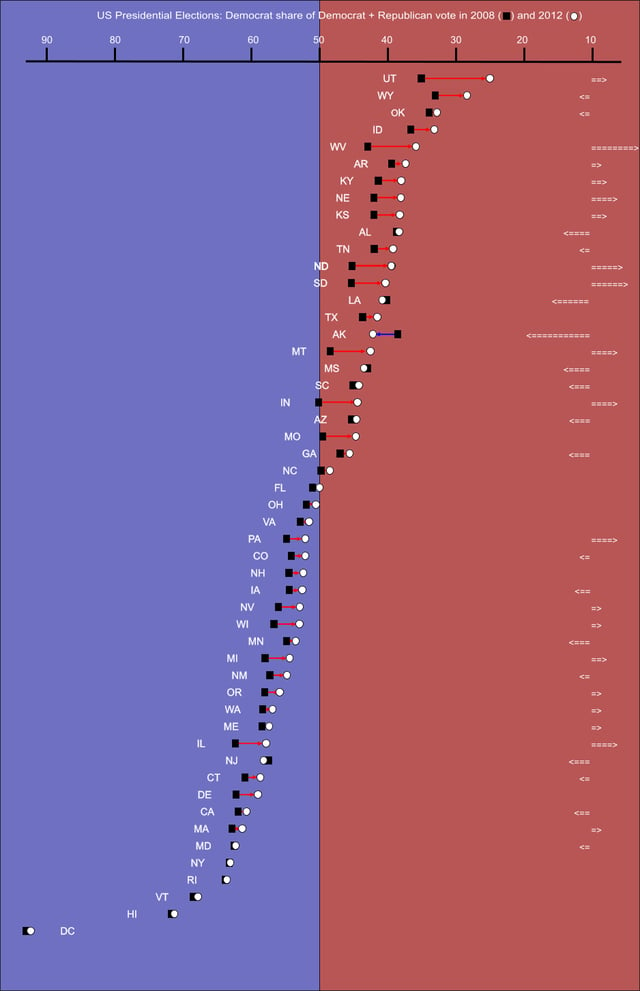
Swing from 2008 to 2012 in each state. Only six states swung more Democratic in 2012: Alaska, Louisiana, Maryland, Mississippi, New Jersey, and New York. The arrows to the right represent how many places up or down on the list the state moved since 2008. States are listed by (increasing) percentage of Democratic votes.
Red denotes states (or congressional districts that contribute an electoral vote) won by Republican Mitt Romney; blue denotes those won by Democrat Barack Obama.
State where the margin of victory was under 1% (29 electoral votes):
Florida, 0.88%
States where the margin of victory was under 5% (46 electoral votes):
North Carolina, 2.04%
Ohio, 2.98%
Virginia, 3.87%
States/districts where the margin of victory was between 5% and 10% (120 electoral votes):
Colorado, 5.37% (tipping point state)
Pennsylvania, 5.39%
New Hampshire, 5.58%
Iowa, 5.81%
Nevada, 6.68%
Wisconsin, 6.94%
Nebraska's 2nd Congressional District, 7.16%
Minnesota, 7.69%
Georgia, 7.82%
Maine's 2nd Congressional District, 8.56%
Arizona, 9.06%
Missouri, 9.38%
Michigan, 9.50%
Romney's concession

Obama takes a phone call from Romney conceding the election early Wednesday morning in Chicago.
After the networks called Ohio (the state that was arguably the most critical for Romney, as no Republican has ever won the Presidency without carrying it) for Obama at around 11:15 PM EST on Election Day, Romney was ready to concede the race, but hesitated when Karl Rove strenuously objected on Fox News to the network's decision to make that call.[122][123] However, after Colorado and Nevada were called for the President (giving Obama enough electoral votes to win even if Ohio were to leave his column), in tandem with Obama's apparent lead in Florida and Virginia (both were eventually called for Obama), Romney acknowledged that he had lost and conceded at around 1:00 AM EST on November 7.
Despite public polling showing Romney behind Obama in the swing states of Nevada, Colorado, Iowa, Wisconsin, Ohio, and New Hampshire, tied with Obama in Virginia, and just barely ahead of Obama in Florida, the Romney campaign said they were genuinely surprised by the loss, having believed that public polling was oversampling Democrats.[124] The Romney campaign had already set up a transition website, and had scheduled and purchased a fireworks display to celebrate in case he won the election.[125][126]
On November 30, 2012, it was revealed that shortly before the election, internal polling done by the Romney campaign had shown Romney ahead in Colorado and New Hampshire, tied in Iowa, and within a few points of Obama in Wisconsin, Pennsylvania, Minnesota, and Ohio.[127] In addition, the Romney campaign had assumed that they would win Florida and Virginia.[128] The polls had made Romney and his campaign team so confident of their victory that Romney did not write a concession speech until Obama's victory was announced.[129][130]
Reactions
Foreign leaders reacted with both positive and mixed messages. Most world leaders congratulated and praised Barack Obama on his re-election victory. However, Venezuela and some other states had tempered reactions. Pakistan commented that Romney's defeat had made Pakistan-United States relations safer. Stock markets fell noticeably after Obama's re-election, with the Dow Jones Industrial Average, NASDAQ, and the S&P 500 each declining over two percent the day after the election.[131] By his inauguration, however, the markets had gained back all the losses[132] and a bull run began that culminated in 2015 when the Dow closed at an all-time high of 18,312,[133] the NASDAQ reached the milestone of 5,210,[134] and the S&P 500 peaked at a record 2,130.[135]
Voter demographics
| 2012 Presidential vote by demographic subgroup | |||||||
|---|---|---|---|---|---|---|---|
| Demographic subgroup | Obama | Romney | Other | % of total vote | |||
| Total vote | 51 | 47 | 2 | 100 | |||
| Ideology | |||||||
| Liberals | 86 | 11 | 3 | 25 | |||
| Moderates | 56 | 41 | 3 | 41 | |||
| Conservatives | 17 | 82 | 1 | 35 | |||
| Party | |||||||
| Democrats | 92 | 7 | 1 | 38 | |||
| Republicans | 6 | 93 | 1 | 32 | |||
| Independents | 45 | 50 | 5 | 29 | |||
| Gender | |||||||
| Men | 45 | 52 | 3 | 47 | |||
| Women | 55 | 44 | 1 | 53 | |||
| Marital status | |||||||
| Married | 42 | 56 | 2 | 60 | |||
| Unmarried | 62 | 35 | 3 | 40 | |||
| Sex by marital status | |||||||
| Married men | 38 | 60 | 2 | 29 | |||
| Married women | 46 | 53 | 1 | 31 | |||
| Single men | 56 | 40 | 4 | 18 | |||
| Single women | 67 | 31 | 2 | 23 | |||
| Race/ethnicity | |||||||
| White | 39 | 59 | 2 | 72 | |||
| Black | 93 | 6 | 1 | 13 | |||
| Asian | 73 | 26 | 1 | 3 | |||
| Other | 58 | 38 | 4 | 2 | |||
| Hispanic | 71 | 27 | 2 | 10 | |||
| Religion | |||||||
| Protestant or other Christian | 42 | 57 | 1 | 53 | |||
| Catholic | 50 | 48 | 2 | 25 | |||
| Mormon | 21 | 78 | 1 | 2 | |||
| Jewish | 69 | 30 | 1 | 2 | |||
| Other | 74 | 23 | 3 | 7 | |||
| None | 70 | 26 | 4 | 12 | |||
| Religious service attendance | |||||||
| More than once a week | 36 | 63 | 1 | 14 | |||
| Once a week | 41 | 58 | 1 | 28 | |||
| A few times a month | 55 | 44 | 1 | 13 | |||
| A few times a year | 56 | 42 | 2 | 27 | |||
| Never | 62 | 34 | 4 | 17 | |||
| White evangelical or born-again Christian? | |||||||
| White evangelical or born-again Christian | 21 | 78 | 1 | 26 | |||
| Everyone else | 60 | 37 | 3 | 74 | |||
| Age | |||||||
| 18–24 years old | 60 | 36 | 4 | 11 | |||
| 25–29 years old | 60 | 38 | 2 | 8 | |||
| 30–39 years old | 55 | 42 | 3 | 17 | |||
| 40–49 years old | 48 | 50 | 2 | 20 | |||
| 50–64 years old | 47 | 52 | 1 | 28 | |||
| 65 and older | 44 | 56 | 0 | 16 | |||
| Age by race | |||||||
| Whites 18–29 years old | 44 | 51 | 5 | 11 | |||
| Whites 30–44 years old | 38 | 59 | 3 | 18 | |||
| Whites 45–64 years old | 38 | 61 | 1 | 29 | |||
| Whites 65 and older | 39 | 61 | n/a | 14 | |||
| Blacks 18–29 years old | 91 | 8 | 1 | 3 | |||
| Blacks 30–44 years old | 94 | 5 | 1 | 4 | |||
| Blacks 45–64 years old | 93 | 7 | n/a | 4 | |||
| Blacks 65 and older | 93 | 6 | 1 | 1 | |||
| Latinos 18–29 years old | 74 | 23 | 3 | 4 | |||
| Latinos 30–44 years old | 71 | 28 | 1 | 3 | |||
| Latinos 45–64 years old | 68 | 31 | 1 | 3 | |||
| Latinos 65 and older | 65 | 35 | n/a | 1 | |||
| Others | 67 | 31 | 2 | 5 | |||
| Sexual orientation | |||||||
| LGBT | 76 | 22 | 2 | 5 | |||
| Heterosexual | 49 | 49 | 2 | 95 | |||
| Education | |||||||
| Not a high school graduate | 64 | 35 | 1 | 3 | |||
| High school graduate | 51 | 48 | 1 | 21 | |||
| Some college education | 49 | 48 | 3 | 29 | |||
| College graduate | 47 | 51 | 2 | 29 | |||
| Postgraduate education | 55 | 42 | 3 | 18 | |||
| Family income | |||||||
| Under $30,000 | 63 | 35 | 2 | 20 | |||
| $30,000–49,999 | 57 | 42 | 1 | 21 | |||
| $50,000–99,999 | 46 | 52 | 2 | 31 | |||
| $100,000–199,999 | 44 | 54 | 2 | 21 | |||
| $200,000–249,999 | 47 | 52 | 1 | 3 | |||
| Over $250,000 | 42 | 55 | 3 | 4 | |||
| Union households | |||||||
| Union | 58 | 40 | 2 | 18 | |||
| Non-union | 49 | 48 | 3 | 82 | |||
| Region | |||||||
| Northeast | 59 | 40 | 1 | 18 | |||
| Midwest | 51 | 48 | 2 | 24 | |||
| South | 46 | 53 | 1 | 36 | |||
| West | 54 | 43 | 3 | 22 | |||
| Community size | |||||||
| Big cities (population over 500,000) | 69 | 29 | 2 | 11 | |||
| Mid-sized cities (population 50,000 to 500,000) | 58 | 40 | 2 | 21 | |||
| Suburbs | 48 | 50 | 2 | 47 | |||
| Towns (population 10,000 to 50,000) | 42 | 56 | 2 | 8 | |||
| Rural areas | 37 | 61 | 2 | 14 | |||
Hispanic vote
The United States has a population of 50 million Hispanic and Latino Americans, 27 million of whom are citizens eligible to vote (13% of total eligible voters). Traditionally, only half of eligible Hispanic voters vote (around 7% of voters); of them, 71% voted for Barack Obama (increasing his percentage of the vote by 5%); therefore, the Hispanic vote was an important factor in Obama's re-election, since the vote difference between the two main parties was only 3.9%[136][137][138][139]
Analysis
Combined with the re-elections of Bill Clinton and George W. Bush, Obama's victory in the 2012 election marked only the second time in American history that three consecutive presidents were each elected to two or more full terms (the first time being the consecutive two-term presidencies of Thomas Jefferson, James Madison, and James Monroe).[143] This was also the first election since 1944 in which neither of the major candidates had any military experience.[144]
The 2012 election marked the first time since Franklin D. Roosevelt's last two re-elections in 1940 and 1944 that a Democratic presidential candidate won a majority of the popular vote in two consecutive elections.[145] Obama was also the first president of either party to secure at least 51% of the popular vote in two elections since Dwight Eisenhower in 1952 and 1956.[146] Obama is the third Democratic president to secure at least 51% of the vote twice, after Andrew Jackson and Franklin D. Roosevelt.[147] Romney won the popular vote in 226 congressional districts making this the first time since 1960 that the winner of the election did not win the popular vote in a majority of the congressional districts.[148] Romney also became the first Republican since Gerald Ford's narrow defeat to Jimmy Carter, in 1976, to fail to win a presidential election while earning a minimum of 200 electoral votes.
Romney lost his home state of Massachusetts, becoming the first major party presidential candidate to lose his home state since Democrat Al Gore lost his home state of Tennessee to Republican George W. Bush in the 2000 election.[149] Romney lost his home state by more than 23%, the worst losing margin for a major party candidate since John Frémont in 1856.[150] Even worse than Frémont, Romney failed to win a single county in his home state.[151][152] In addition, since Obama carried Ryan's home state of Wisconsin, the Romney–Ryan ticket was the first major party ticket since the 1972 election to have both of its nominees lose their home states.[153] Romney won the popular vote in every county of three states: Utah, Oklahoma, and West Virginia; Obama did so in four states: Vermont, Massachusetts, Rhode Island, and Hawaii.[154]
Romney's loss prompted the Republican National Committee to try to appeal to the American Latino population by concentrating on different approaches to immigration. These were short-lived due to activity and anger from the Republican base and may have contributed to the selection of Donald Trump as their presidential candidate four years later.[155]
Gary Johnson's popular vote total set a Libertarian Party record, and his popular vote percentage was the second-best showing for a Libertarian in a presidential election, trailing only Ed Clark's in 1980.[156] Johnson would go on to beat this record in the 2016 presidential election, winning the most votes for the Libertarian ticket in history. At the time, Green Party candidate Jill Stein's popular vote total made her the most successful female presidential candidate in a general election in United States history.[157][158] This was later surpassed by Hillary Clinton in the 2016 election.
Obama's vote total was the second most votes received in the history of presidential elections and the most ever for a reelected president. Obama owns the all-time record for votes in a single election as well in 2008. However, Obama also became the first president in American history to be reelected to a second term by smaller margins in every way possible: Compared to his victory in 2008, he won fewer states (28 to 26), fewer electoral votes (365 to 332), fewer popular votes (69.5 million to 65.9 million), a smaller percentage of the popular vote (52.9% to 51.1%), and fewer congressional districts (242 to 209).[159]
As Obama's performance in Washington D.C. in 2012 was slightly weaker than his own performance in the district in 2008, a streak of five consecutive elections of repeated unprecedentedly larger and larger Democratic margins of victory which had lasted from 1992 to 2008 within the district was broken. In 2016, Hillary Clinton's margin of victory in the district exceeded Obama's 2008 margin, bringing the district back into the routine of providing unprecedentedly large Democratic victories, making 2012 a clear outlier to these trends.

